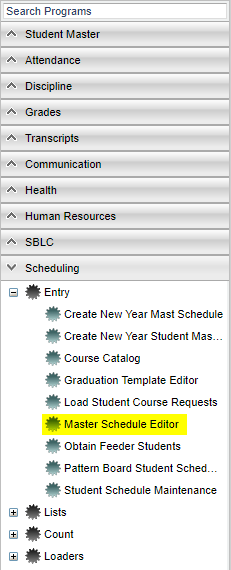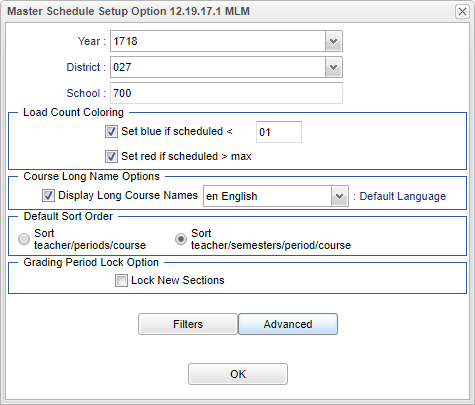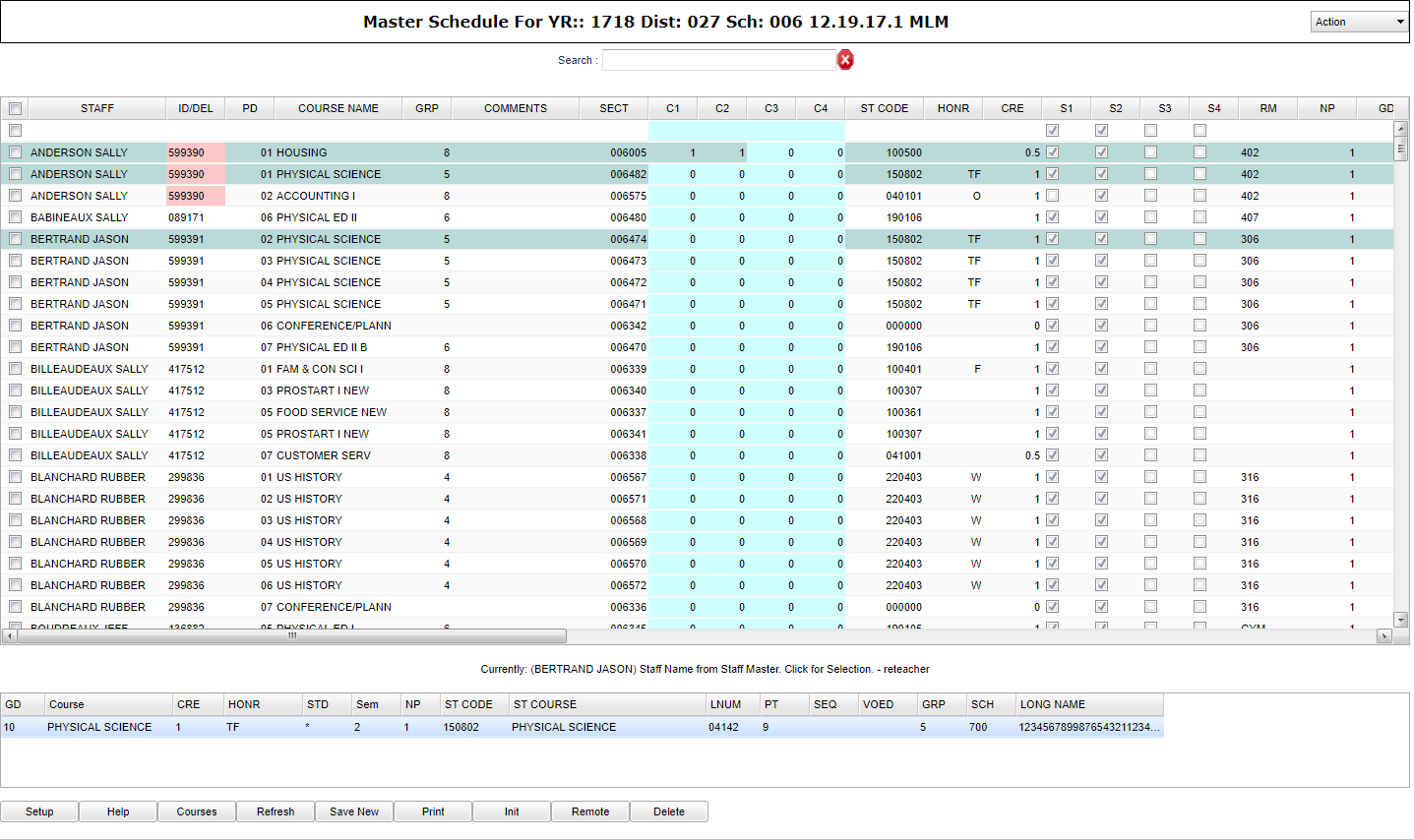Master Schedule Editor
This
Video
Menu Location
 Click on Scheduling. Under Entry, select Master Schedule Editor.
Click on Scheduling. Under Entry, select Master Schedule Editor.
Setup Options
 To find definitions for standard setup values, follow this link: Standard Setup Options.
To find definitions for standard setup values, follow this link: Standard Setup Options.
Year--Defaults to the current year. A prior year may be accessed by clicking in the field and making the appropriate selection from the drop down list.
District--Default value is based on your security settings. You will be limited to your district only.
School--Default value is based on your security settings. If you are assigned to a school, the school default value will be your school site code. You will not be able to change this value. If you are a supervisor or other district office employee with access to the Student Information System, you will be able to run programs for one school, a small group of schools, or all schools in your district.
Load Count Coloring
- Check the box next to Set blue if scheduled < if it is desired that the fields C1 - C4 be blue when the count of students is less that the number set in this field.
- Check the box next to Set red if scheduled is > max if it is desired that the fields C1 - C4 be red when the count of students is greater than the max count set for the class.
Course Long Name Option
- Check the box next to Display Ling Course Name - Select this option to display the long course name in the master schedule screen. The default language is English.
Default Sort Order
- Sort teacher/periods/course - Select the default sort order for the master schedule records when they are displayed on the screen.
- Sort teacher/semester/period/course - Select the default sort order for the master schedule records when they are displayed on the screen.
Grading Period Lock Option
- Check the box next to Lock New Sections - Select to lock all new section's grading periods and deny all user's access.
Filters (tab)
Courses List Function
- Check the box next to Include obsolete courses in pick list to display obsolete courses in the course pick list.
- Select Course Grades to display course grade levels for availability.
NOTE - To prevent school personnel from seeing obsolete courses in the Master Schedule Editor, you will need to select the following in User Management.
User Management -> Category of Scheduling -> Program of Master Schedule Editor -> Action of Allow Obsolete Course Selection - set to Do Not Allow.
Table Filters
- Select Teacher Selection to filter by specific teachers.
- Select Periods to filter the master schedule class periods to process.
- Select Courses to filter by specific courses.
- Select Grades to filter by grade level.
- Select Transcript Groups to filter by specific groups.
Click OK or Cancel to proceed.
Advanced (tab)
Master Schedule Editor Advanced Selections - choose whether to Edit Original Master Schedule or to Edit October Master Schedule.
- CheckEdit Original Master Schedule to work in a live Master Schedule the system is using.
- Check Edit October Master Schedule is a copy of the Original Master Schedule on October 2 at 12:01 a.m. used in October 1 LEADS State Reporting.
Update Block Scheduling System
- Check Yes - Validate Changes to update the block scheduling records to match the master schedule records when they are changed.
- Check No - Do Not Validate Changes to no update the block scheduling records when sections are changed.
Load Count Roster Function
- Check Active Only to display the roster based on the as of date.
Set Default Program Actions
- Check Use default max to display the total number of students allowed in a class. Then select a number.
- Check Use School Year For the Contract Year to limit the employees in the employee listing to the current year based on their contract year. Uncheck this box to show all employees non-dependent on their contract year.
Click OK or Cancel to proceed.
Main
Column Headers
To find definitions of commonly used column headers, follow this link: Common Column Headers.
Staff: Staff name from Staff Master
ID/DEL: This is the teacher's staff identification number found in the employee master file.
PD: Class period when the course is being taught.
Course Name: This is the course name from the Course Catalog.
Group: Transcript group from the course file.
Comments: Used to Make Comments about the section
Sect: This is the section number for the current record.
C1,C2,C3,C4: Class Counts for Semester 1,2,3,4
ST CODE: State assigned Code for Courses.
Honr: Honor codes from the course file.
CRED: Credit given to a course in Course Catalog.
S1, S2, S3, S4: This is the section offered in each semester.
RM: This is the room number where the class will be taught.
NP: Number of periods a class is taught.
GD: Grade level of the course being taught.
DS: Distance Learning
Max: This is the maximum number of students in a class.
LKS: This vailue is used by the automatic scheduler to schedule two or more classes together for a student.
DoW: Days of the week when the course is being taught.
Lunch: This is the lunch break time that occurs during a section.
SCH: This is the school where the subject is being taught.
DIS: This is the district in which the subject will be taught.
RSCH: School number of the school where class is taught if not the enrolled school
RDIS: District number of the school where class is taught if not the enrolled school
MREM: Maximum number of students that can be scheduled to a remote class
REM: If checked, this section is offered to other schools as a Remote section that can be pulled into their Master Schedule. NOTE: It will turn the row teal.
REC: Record number
SE SPC: Special Ed Placement Setting Code: will popup when a sped class is created
12HR: Indicates that a teacher is NOT qualified for one of the courses they are teaching, but has earned 12 college credit hours in the subject area
TEAM: Team assignment
DOWTITLE: Day of week titles can be assigned. The user can key in information that will printout under the AB Dow Title on the student schedules.
C HRS: College hours for a Dual Enrollment course.
PSEC SITE: Post Secondary site for a Dual Enrollment course.
ADD STAFF: This field is used to denote team teachers. NOTE: Allows you to add additional staff and percent of time teaching. The teaching time must add up to be less than 100% total for additional teachers added. This information is for the CUR reporting as it identifies a course being taught by multiple teachers and identifies it in the file as a Y or N. NOTE: It also allows you to assign security permissions to the additional staff. See Multiple Teachers to add the securities. If CR is checked, it means that the section requires that categories be used in the Grade Book.
DP: Difficulty Points are used by the grade book to calculate the marking period final or the exam grades with additional points due to the difficulty of the class. Example: If you have 1.3% as your difficulty points, and your final average is 85%, it will add 1.3 to total 86.3%.
GD TYPE provides a list of custom grading scales created in the Sponsor Site Editor on the Grading Scale tab using the Grading Scales Manager under the Action drop down. When selecting the grade type and using the grade scale database for the listing, if more than one grade type is selected, one and only one of the selections must have the semester final option selected as "Y". If only one grade type is selected, the final semester does not have to be selected. When a custom grading scale is selected, the teacher assigned to the section will be required to use the grading scale in their WebGradebook. No other option will be available.
RSec is the section number that will be reported to the state instead of the actual section number for the selected record.
Fees - fee amount for the section/class.
Weight provides a list of custom marking period weights created in the Sponsor Site Editor on the Grading Scale tab using the Course Weights Manager under the Action drop down. When a custom marking period weight is selected, the selected section will use those weights.
Fees: This section's fee amount is for this section.
Long Name will give the user the ability to enter a full descriptive name of the course without a limit as well as allowing the user to enter the name in multiple languages.
Course Catalog Column Headers
- GD: Course grade.
- Course: Course name.
- CRE: Credit value.
- HONR: Honor code(s).
- STD: Standard flag.
- Sem: Number of semesters.
- NP: Number of class periods.
- ST CO: State code.
- St Course: State course name.
- LNUM: Local number.
- PT: Priority level.
- SEQ: Sequence code.
- VOED: Vocation course code.
- GRP: Transcript group.
- SCH: School number.
- Long Name: Course long name.
Bottom
Setup: Returns you to the Set up Box; see instructions above
Help: Written instructions and instructional videos
Courses: Takes you to the Course Catalog
Refresh: Refreshes the page to show new counts
Save New: Use only when making a new section using the top blank line
Print: Allows you to print or save the current screen of all teacher's sections in a list format. To find the print instructions, follow this link: Standard Print Options.
Init: Click for directions to re-index class counts.
Remote: Click for directions on setting up "hosted" and "remote" classes.
Delete: Used for deleting multiple sections.
Top
Action Button Delete Scheduled Students by Section - allows you to delete a group of students at one time
Print Selected Teachers - allows you to print or Save one teacher's sections in a list format
- Adding or Changing a Section in the Master Schedule
- Dual Enrollment Courses in the Master Schedule
- Initialize (Re-Index) Class Counts in the Master Schedule
- Remote Classes in the Master Schedule
- Rearranging the Master Schedule Display (Working with On Screen Lists)
